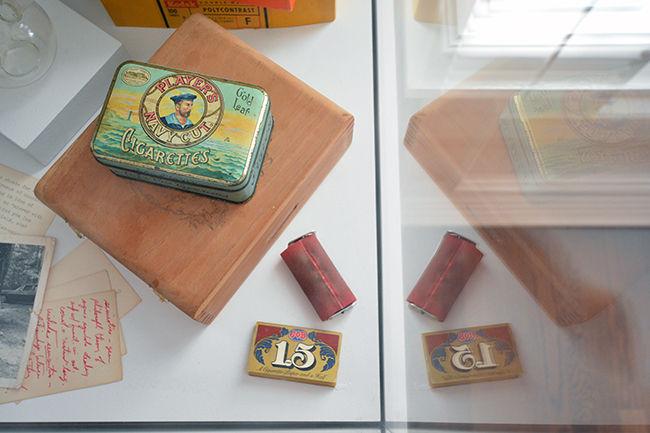The late photographer John Menapace chose not to name his photos; he preferred they speak for themselves.
Smokes and Mirrors: Reflections of the Self in Photographs by John Menapace, an exhibition currently on display at the Gregg Museum of Art & Design’s temporary location, exemplifies Menapace’s unique style. Furniture is sparse, leaving ample room for visitors to wander. Plush red carpets absorb the sound of footsteps. The only focal points are the pieces of Menapace’s collection, which stand out being devoid of color.
Menapace’s photographs may seem to the casual observer unassuming, but upon a closer look, one will find a pronounced conciseness and a sense of intent. Rather than passively gaze over the photos, Menapace wanted viewers to engage. A plaque summarizing the exhibition states, “He wanted viewers to experience the images on their own terms and to discover their own meanings and stories in them.”
Elizabeth Matheson, Menapace’s former student, donated the collection to the Gregg Museum in early 2011. According to her, the collection is composed of the majority of Menapace’s life work.
Belén Morata-Ruiz, the co-curator of the exhibition, worked previously in Spain and the United Kingdom as a photo historian. Since the end of June 2012, Morata and Sammy Kirby, a retired lawyer, have worked with the collection of Menapace’s work, meticulously cataloguing and preserving his pieces. So far, they archived about 6,000 prints of what, in the end, may be about 29,000 prints in total.
Smokes and Mirrors utilizes selections from this archive, many of which have never before been exhibited. Some of the most fascinating photos are those that are less well known. Morata said that Menapace’s self-portraits were experimental in nature—he used himself as a fixture of the environment.
Matheson spoke fondly about her former teacher.
“Certainly, he was a generous teacher and mentor, open to anyone who showed up with pictures or technical questions,” Matheson said. “His work, thanks to the Gregg, will continue to enrich and delight.”
Morata also praised Menapace’s work, describing him as the “father of North Carolina photography.”
“He started with some workshops at Duke University,” Morata said. “Photography in North Carolina was not something that was established at that point. It was not considered artwork.”
However, according to Morata, Menapace didn’t consider himself an “artist.”
“He wasn’t a real artist,” Morata said. “He didn’t want to be called that. He wanted to be called a photographer, and that was important to him, but he always insisted that he didn’t take pictures to become an artist.”
According to Morata, after working with the collection he came to the conclusion that Menapace’s two main influences were French photographer Eugène Atget and Ansel Adams.
Zoe Starling, the Curator of Education at the Gregg Museum said Menapace’s primary influences specialized in black and white photography.
“He refused to take pictures in color,” Starling said.
But while Adams concentrated on sweeping landscapes and Atget studied the imminent changes of his environment, Menapace was fascinated by lines and specificity.
“There is a big difference between his first work and that at the end of his life,” Morata said. “His first pieces were related to documentary photography—similar to Atget’s work—but as his work evolved, it delved more into abstraction.”
And yet, while Menapace’s style evolved, Morata said he kept the same subjects: seemingly ordinary environments that appear more intriguing upon a second glance.
“The scenes are always the same—random houses, views, landscapes, interiors,” Morata said. “But the difference between his early work and his later work is the way in which he takes the pictures.”
The title of the exhibition, Smokes and Mirrors, in addition to referencing Menapace’s smoking habit, alludes to the introspective nature of Menapace’s photography. Menapace encouraged his audience to look past the “smoke and mirrors” of daily life, to engage in the truth and its simplicity rather than become ensnared with trivialities, according to Starling.
“My work with this collection has been an incredible and fascinating journey, deep into this master’s work through something as personal and intimate as his photographs,” Morata said.








